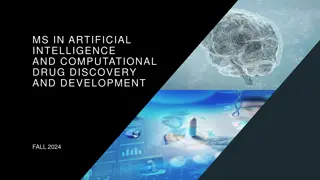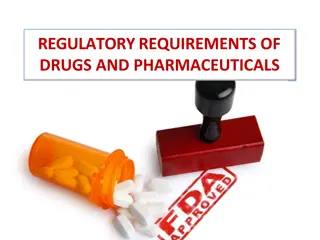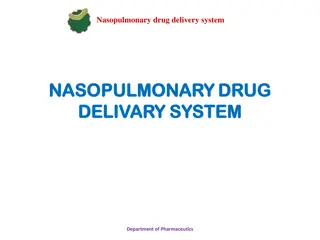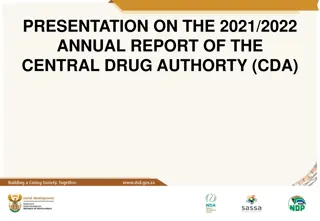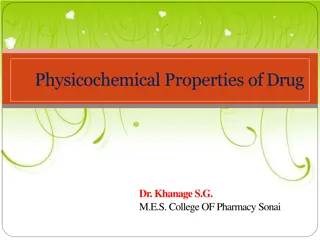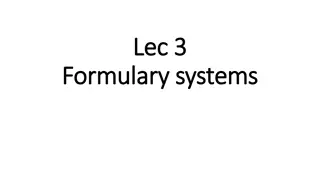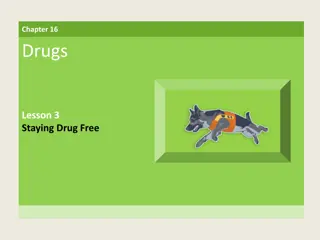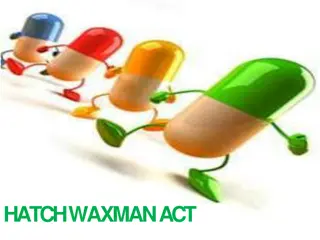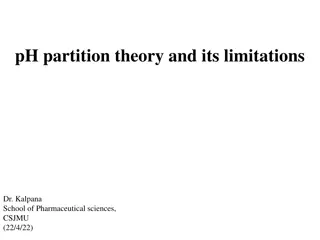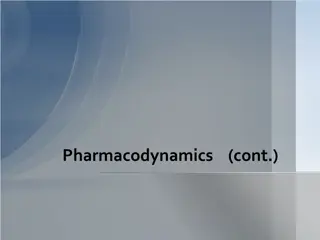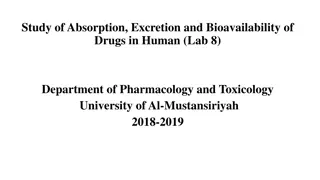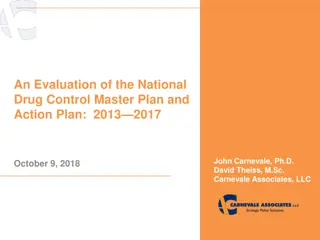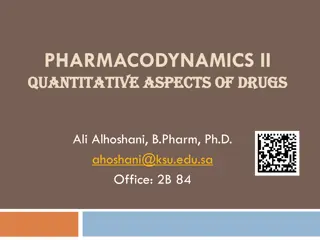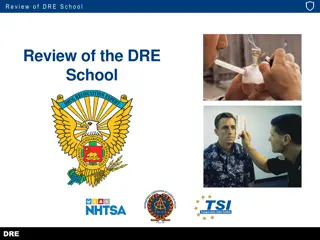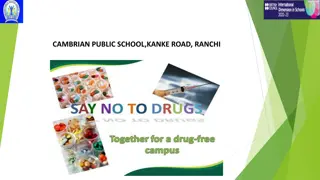National Drug Master Plan 2019-2024 Presentation Overview
The presentation provides insights into the National Drug Master Plan 2019-2024, discussing its introduction, purpose, background, situational analysis, and concerns addressed. Key elements include policy shifts, stakeholder engagement, strategic intent, outcomes, and population targets. The plan aims to address substance abuse effectively in alignment with the Prevention of and Treatment for Substance Abuse Act.
Download Presentation

Please find below an Image/Link to download the presentation.
The content on the website is provided AS IS for your information and personal use only. It may not be sold, licensed, or shared on other websites without obtaining consent from the author.If you encounter any issues during the download, it is possible that the publisher has removed the file from their server.
You are allowed to download the files provided on this website for personal or commercial use, subject to the condition that they are used lawfully. All files are the property of their respective owners.
The content on the website is provided AS IS for your information and personal use only. It may not be sold, licensed, or shared on other websites without obtaining consent from the author.
E N D
Presentation Transcript
PRESENTATION ON NATIONAL DRUG MASTER PLAN 2019 - 2024 18 AUGUST 2020 1
Introduction of the National Drug Master Plan 2019 2024 by DSD The Prevention of and Treatment for Substance Abuse Act, Act No. 70 of 2008, provide the Department of Social Development to host the Central Drug Authority (CDA) The Department supported the development and the implementation of the National Drug Master Plan Minister of Social Development presented the National Drug Master Plan 2019 2024 to cabinet in September and October 2019. It was approved by Cabinet in Oct 2019 On 26 June 2020, the Minister launched the NDMP during the International Day Against Drug Abuse and Illicit Trafficking. Minister is aware of the challenges faced by the CDA and is addressing them by reviewing the legislation: Prevention of and Treatment for Substance Abuse Act, Act 70 of 2008. 2
Summary of the concerns of the Previous Portfolio Committee They stopped the CDA to present its Annual Report as it did not have an audited financial Statement, as they thought it had the same status a NDA and SASSA They recommended that the CDA should be a government component like Government Printing Works or similar entities. Their argument was that most entities have problems of governance and do not deliver as required by the Government They wanted the National Drug Master Plan to be The National Anti- Substance Abuse Plan. 3
PURPOSE OF PRESENTATION To present the following: Background Situational Analysis Policy shift on understanding addiction Stakeholder engagement Strategic intent Outcome and target population Review of plan Conclusion and attachments 4
1. Background The 4th edition National Drug Master Plan is a single document covering all national concerns regarding drug control It summarises national policies authoritatively It defines priorities and allocate responsibilities for drug control efforts and is a national strategy It is drafted in accordance with the Prevention of and Treatment for Substance Abuse Act, Act 70 of 2008 5
2. Situational Analysis The use of substances has effect on the Central Nervous System, comprising the brain and spinal cord. International overview: Alcohol consumption and associated problems vary widely, and the burden of alcohol related disease and death is significant in most countries South African overview: South Africa has adopted a drastic change in addressing in approach to drug policy. It embarked on evidence-based public health and social justice principles. The following drugs are popular in South Africa: Alcohol, cannabis, tobacco, white pipe and Nyaope/ woonga. 6
3. Policy Shift on understanding Addiction The new approach calls South Africa to know: Addiction is a disease that affect the brain and behaviour to assist us to understand drug use and the appropriate response Addiction is defined as a chronic, relapsing brain disease characterised by compulsive substance seeking, despite the harmful consequences Repeated use of drugs can change the structure of the brain over time. Change the way the cells normal function- send, receive and process information. 7
Link Between NDMP with AU Protocol and UNGASS Outcomes The National Drug Master Plan is a country strategic document to guide stakeholders on measures to combat alcohol, and other substances of abuse in the country. South Africa is a Member State of African Union, and the Deputy Minister is the leader in AU Ministers for Drug Control. During her tenure she participated in the development of African Union Plan of Action (AUPA) on Drug Control and Crime Prevention as well as protocol on combating Illicit Drug Trafficking in the continent. Hence, South Africa is implementing AUPA. Annually, the CDA has to consolidate all efforts and provide progress to AU on how the drugs and crime were combated, including the medication assisted therapy for users, number of clandestine laboratories dismantled and drug available to manage pain. 8
Link Between NDMP with AU Protocol and UNGASS Outcomes cont The outcome document adopted by Member States of the United Nations General Assembly Special Session in 2016, called on countries to consider measures such as appropriate medication- assisted therapy, injecting equipment programmes and antiretroviral therapy to prevent the transmission of HIV, viral hepatitis and other blood -borne viruses. The current NDMP 2019 2024 has considered the measures mentioned above and treat people who use drugs and injecting drugs as their human rights. 9
4. Stakeholder Engagement During the review of the NDMP, stakeholder consultation was key and extensive. Stakeholders refer to a person or group with an interest or involvement on something. The success depend whether the interest is low of high. Stakeholders include everyone, departments, CSO, including PWUD and PWID. In pages 40 43 : listed roles of departments, entities and business units. These stakeholders are mandated by the Prevention of and Treatment for Substance Abuse Act, 70 of 2008 to perform their duties as imposed by the Act. 10
5. Strategic Intent The vision of NDMP: South Africa free from substance abuse Mission: To embrace a balanced, integrated and evidence based approach; invest in building safe communities, control the demand and supply of substances; invest substances for therapeutic use and coordinate and combat substance abuse. 11
5. Strategic intent cont Principles: Right-based, evidence-based, multi-sectoral and multilateral, people centred, inclusive and participatory Goals: 1) Demand reduction; 2)Supply reduction, 3)Ensure availability of and access to controlled substances for medical and scientific, 4) Identification and control of New Psychoactive substances, 5) Promote governance, leadership and accountability, 6) Strengthen data collection, monitoring and evaluation, and 7) Stimulate robust and sustainable economic growth aimed at reducing poverty, unemployment and inequalities. These goals reduce demand and supply of drugs and increase harm reduction treatment 12
6. NDMP STRATEGIES Demand, supply and harm reduction strategies: Demand reduction Harm reduction Supply reduction 13
6. NDMP STRATEGIES Demand reduction interventions: Poverty reduction Advocacy Community development Demand reduction results Social policy Education and communication 14
6. NDMP STRATEGIES Supply reduction interventions: TRENDS LEGAL ACTION PRODUCTI- ON SUPPLY PRICES CONTROL REDUCTION RESULTS TRAFFIC- KING PURITY CON- SUMPTION 15
6. NDMP STRATEGIES Harm reduction interventions: DETOX & REHAB LIMITING SPREAD OF IDU DISEASES AFTER- CARE & RE-INTEGRATION HARM REDUCTION RESULTS CONTROL OF DISTRIBUTION AND ACCESS MEDICAL TREATMENT EDUCATION & COMMUNIC- ATION SUBSTITU- TION THERAPY 16
7. Outcome and Target population NDMP will be evaluated whether is has achieved the following outcomes in medium term strategic framework: Outcomes: 1)Reduced levels of poverty; 2)reduced levels inequality, 3) Reduced levels of Social ills, improved well-being of children, families and communities, 4) Empowered, resilient individuals, families and sustainable communities and, 5) Improved sector capability. Priorities, areas and target population: Youth, Children, women, persons with disabilities, pregnant women, families, including child-headed household, vulnerable communities, occupational groups at risk, and Key populations. All interventions relating to goals are explained in this chapter. 17
8. Review of plan NDMP 2019 2024 is a living document and will be adapted in line with the research evidence and local trends in drug use and misuse. 18
9.Conclusion NDMP 2019 2024 represents a multi-sectoral approach to create a South Africa free from the harm associated with drug use, misuse and abuse. This plan observes national and international policies, plans and conventions to ensure respect and dignity for all people in South Africa. 19
10. Monitoring and Evaluation Monitoring and Evaluation has measurable indicators and guide the implementers. Addenda: 1. Implementation plan: Guide implementation 2. Risk Management Plan : Mitigate risks 20
Financing of the National Drug Master Plan 2019 - 2024 The Department of Social Development allocate finances for the functioning of the CDA and the monitoring of the NDMP 2019 2024 Departments serving on the CDA (national, Provincial and Municipalities) are obliged by the Act to individually provide financial and human resources for the implementation of the National Drug Master Plan (hence, most provincial departments have dedicated units) to implement NDMP. DSD allocates a minimum of R3 million for the CDA and administration of NDMP Furthermore, DSD has a dedicated budget from the Substance Abuse Directorate to implement the programmes listed in the NDMP and provide the CDA with a report on how they have combated substance abuse. The other departments do similarly. 21
CDA Challenges and Responses Challenge: Submission of the CDA Annual Report to Parliament late Response: CDA to ensure that Provincial Substance Abuse Forums and national Departments submit their reports on quarterly basis. At the end of the 4th Quarter the CDA would develop the annual report from the available information. Challenge: Development of Departmental Drug Master Plans (DDMPs) by national departments and Provincial Drug Master Plans (PDMPs) by provincial forums are not being monitored Response: CDA to formally communicate with HODs and DGs and explain the importance of these Drug Master Plans and what each department needs to address based on the changes in the NDMP 22
CDA Challenges and Responses Challenge: Improve current functioning of the CDA to provide more direct guidance for and monitoring of the implementation of the NDMP by national departments, provinces and local authorities Response: The CDA Chairperson, CDA members and experts in the CDA should prioritise visits to provincial Premiers office and DGs to gain their buy-in and support for PSAFs and assist with holding non-compliant departments accountable Challenge: Positioning and structure of the CDA- CDA to be independent like NDA, SASSA and SAHPRA Response: 1) CDA to be moved to the Presidency and financed from the National Treasury. 2) CDA should report to the Minister and its Secretariat report to the line function and be appointed to support the CDA 23
THANK YOU 24




